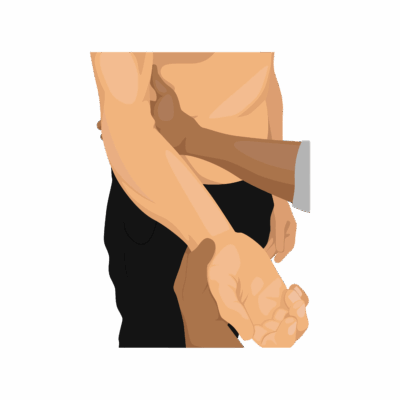Varus Stress Test (Elbow)
The Varus Stress Test is an orthopedic procedure designed to assess the integrity of the lateral collateral ligament (LCL, also called radial collateral ligament) of the elbow. This ligament helps stabilize the outer (lateral) side of the elbow, which can be compromised by trauma, repetitive stress, or sports injuries.
How the Test is Performed
-
Client position: Sitting or lying down, arm relaxed and elbow extended, or flexed to 20–30° for better sensitivity.
-
The examiner stabilizes the medial side of the elbow with one hand (acting as a fulcrum).
-
The examiner grasps the wrist with the other hand and applies a varus force (gently pushes the elbow outward, away from the body), stressing the LCL on the lateral side.
-
Observe for pain, gapping (instability), or mechanical symptoms at the lateral elbow compared to the other side.
-
Repeat with the elbow slightly flexed or fully extended for comparison.
Clinical Significance
-
A positive test reveals pain and/or excessive joint laxity on the lateral side of the elbow, suggesting LCL sprain, tear, or instability.
-
Common in patients with elbow trauma, posterolateral instability, or participation in activities that stress the lateral elbow (contact sports, weightlifting, manual labor).
Assessment
-
Use this test for clients complaining of lateral elbow pain, instability, loss of function, or difficulty with pushing/lifting.
-
Document side-to-side differences, pain severity, and sensation during testing.
Treatment
-
If positive:
-
Avoid deep friction, direct mobilization, or aggressive massage over the lateral epicondyle and LCL, especially if acute or painful.
-
Focus on gentle soft tissue work for the forearm extensors, wrist, shoulder stabilizers, and upper back to manage compensatory tension.
-
Educate clients to minimize aggravating activities (heavy lifting, torque movements) and support joint protection during recovery.
-
In chronic cases, gentle mobilization, pain-modifying techniques, and postural correction may help, but avoid overstressing the joint.
-
Safety and Referral
-
Refer promptly for medical evaluation if instability, acute trauma, functional loss, or severe pain is present—imaging may be needed to confirm LCL tears.
-
Modify manual therapy based on injury stage and always collaborate with rehabilitation professionals as needed.

